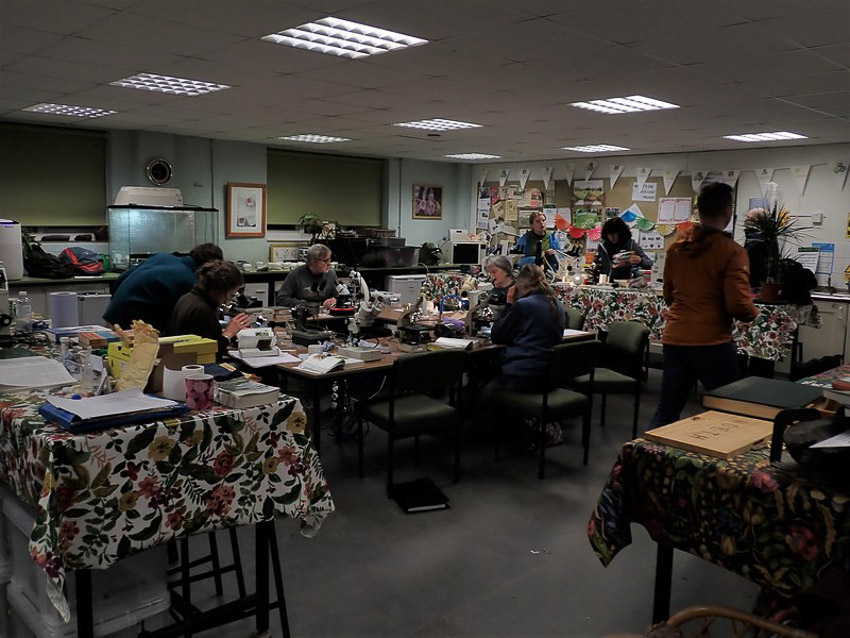
Liverwort Course at Treborth Botanic Gardens, Feb 11-13th, 2022
Workshop report
A group of eleven people met at Treborth Botanic Gardens near Bangor to join Lucia Ruffino and Philippa Thompson for the BBS Liverwort Beginner’s workshop. The group were very fortunate to be supported by Shaun Russell, former curator of the Botanic Garden, and now Co-director of the Friends of Treborth, who brought his wide experience of scientific bryological research from all over the world to enrich our time at Treborth over the three days.
The workshop began on Friday evening with a short introductory presentation by Lucia. The microscopes were then set up to give everyone a chance to settle in and to help those who had never used a microscope before to find out how to use them.
The weather forecast was predictably dire for the entire weekend, but miraculously the skies cleared sufficiently on Saturday morning for the group to have a brief field excursion around the Botanic Gardens. The gardens are situated on a piece of land that has a limestone boundary running through it. We headed straight down to the shore of the Menai Strait, via a rather muddy set of steps with a rickety handrail (not mentioned in the Health and Safety document!). The group spent quite some time negotiating the steps – not because of their rickety condition, but because they were framed by copious cushions of Saccogyna viticulosa and patches of Lophocolea bidentata, Lejeunia lamacerina and Calypogeia fissa! Along the shoreline there was a long muddy bank colonised by tufa forming species where Plagiochila porelloides, and Mesoptychia turbinata were examined. There was an opportunity to look at Fissidens dubius and to compare it with Diplophyllum albicans. Under the waterfall were sheets of Conocephalum conicum, Pellia endivifolia and small patches of Lunularia cruciata. On the way back through the gardens there was a chance to look for epiphytes such as Metzgeria furcata, Microlejeunia ulicina, Cololejeunia minutissima and Frullania dilatata, the latter with copious perianths.
After lunch the rain intensified and the rest of the afternoon was spent in the labs, keying through leafy liverwort species, looking at slime papillae in Pellia epiphylla and P. endiviifolia, and identifying some of the material that was collected in the morning. The session was broken by a guided tour of the glasshouses by Shaun, a treat for all, comprising of a rich cornucopia of scarce tropical species which are a hidden gem within North Wales, and a tour of the insectivorous plant house, the responsibility of Pamela Bower, one of the participants on the course and a new member of the North Wales non- flowering Plant Group. The evening meal in the local hostelry was slow to arrive so unfortunately the evening DIY lab session had to be severely curtailed but that was amply compensated for by the convivial atmosphere around the dining table.
Sunday dawned unbright and unfair, and everyone arrived amidst sheets of unrelenting North Wales rain. Field work was out of the question, so the day was spent in the lab working through the range of specimens that had been collected in preparation for the course. Fruiting Marchantia polymorpha was found growing around the sundews in one of the glass houses with gemma cups, antheridiophores and archegoniaphores. A female plant of Phaeoceros laevis was discovered growing with a particularly rare and special cotoneaster. A puzzling thallus growing over the top of a piece of Marchantia turned out to be a male plant of the Phaeoceros with its small volcano like antheridiophores. Much time had been wasted fruitlessly a couple of weeks before, searching for Phaeoceros outside!! Lunchtime was accompanied by a rewarding tour of the BBS library with a peep at some of the interesting antiquarian floras that are held in the library and a visit to the Bangor University Rhizotron (no it is not something from Harry Potter!)!! Afterwards, time was spent by some in cutting thalloid sections and looking at pores and thallus structures, by others looking at their own specimens, before everyone dispersed to go home. Everyone worked incredibly hard and a big thank you to Treborth for making us so welcome and especially to Shaun Russell for providing us with so much help and support. I think that we all benefited greatly from the experience. The group had a really positive dynamic and we thoroughly enjoyed working with you all.
Philippa Thompson, February 2022





